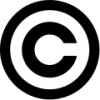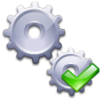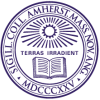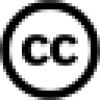Library Copyright & Fair Use
Skip to Main ContentAmherst College adheres to and promotes observance of U.S. copyright laws. Those laws aim to “promote the Progress of Science and useful arts” (Constitution of the United States, Art. I, Sec. 8) and protect the rights of authors, artists, composers, copyright holders, and those who use material produced by others.
What follows are brief, general principles to help members of the Amherst College community follow current U.S. copyright laws. Please be aware that the information on this page is intended to be educational, but is not intended to constitute legal advice. For legal advice regarding a specific intended use, you should always contact an attorney.
Contents
- Material in the public domain
- Material under copyright
- Using copyrighted material by relying on “Fair Use”
- Principles
- Cases
- Open access
- Questions and contacts
1) Material in the Public Domain
You may use work in the public domain, without seeking permission, so long as your use is not defamatory or in violation of other laws unrelated to copyright.
What Is in the Public Domain?
Everything published before 1929, with or without a copyright notice.
- Published work,
- with or without copyright notice,
- created pre-1929
All work published without a copyright notice between 1929 and 1977.
- Published work,
- without copyright notice,
- created 1929-1977
Unpublished work created before 1978 enters the public domain 70 years after the creator’s death.
- Unpublished work,
- 70 years after the creator's death,
- created before 1978
Facts, statistics, and compilations thereof published at any time.
- Facts & statistics,
- with or without copyright notice,
- created any date
Everything published by the U.S. government at any time.
- U.S. government publications,
- created any date
See a full and more nuanced list of what is and is not in the public domain.
2) Material Under Copyright

To use copyrighted material you must do one of the following:
- determine that your use of the material constitutes “Fair Use” (see #3 below);
- obtain permission from the copyright holder;
- pay a fee through a third party such as the Copyright Clearance Center; or
- ask an academic department coordinator to obtain permission on your behalf;
What is Under Copyright?
Work published with a copyright notice, 1929-1978: © until 95 years after publication.
- Published work,
- with copyright notice,
- created 1929-1977
Unpublished work created before 1978: © for 70 years after death of the creator.
- Unpublished work,
- created before 1978
Work created (published or not) after 1978: © until 95 years after the death of the author.
- Published or not,
- with or without copyright notice,
- created post-1978
See a full and more nuanced list of what is and is not in the public domain.
3) Using Copyrighted Material by Relying on "Fair Use"
You may use material under copyright if you determine through informed good faith that your use constitutes “Fair Use.” “Fair Use” guidelines (17 U.S.C. § 107) require you to consider the following four factors:
- The purpose and character of the use: best if for non-profit, educational purposes;
- The nature of the copyrighted work: best if non-fiction and more like data than creative work;
- The amount and substance used relative to the work as a whole: the smaller the amount, the better; and,
- The effect on the potential market or value of the copyrighted work: the smaller the effect, the better.

The University of Minnesota provides a helpful tool for evaluating whether your use of a given work constitutes Fair Use. Of course such a tool is not a substitute for legal advice.
4) Principles
Amount: Few legal analysts question using limited portions of certain materials as part of “mediated instruction” or “classroom use”: a poem, a song, a slide of contemporary art, a movie, or a scene from a play, provided the instructor obtains the material legally and uses it in a face-to-face setting or on a course website.
Restrictions: You can reduce (but not eliminate) your liability by restricting copyrighted material to students enrolled in your courses and by providing said students with notice of their rights and responsibilities. Restricting access does not in itself ensure Fair Use.
Responsibility: Faculty and students are responsible when they infringe copyright law. The college, however, reserves the right to intervene when it suspects violations, and the college will honor takedown requests from those alleging violations during the period required to evaluate the validity of such claims.
Jailbreaking: The U.S. Copyright Office acknowledges that “jailbreaking” protected media may be warranted if the use of that media constitutes Fair Use. See proposed rule.
5) Cases
Some approaches to particular cases appear below.
Movies for classes: Most analysts agree that it is permissible to show entire films in the course of teaching at nonprofit, educational institutions, even if those films are labeled “Home Use Only.” You should be safe if:
- the performance is in a classroom or similar location for instruction; or
- the media is streamed through a course website accessible only to students enrolled in class (see “ISSUE BRIEF: Streaming of Films for Educational Purposes”); or
- the performance is part of a “teaching activity.” The teaching activity need not be part of a regular course. Examples include discussion forums or educational programs related to the film, led by a student or instructor.
Movies for the public: You will almost certainly exceed Fair Use if you show a film under copyright in a setting that is not part of a teaching activity. This includes showings by clubs and non-teaching screenings open to the public. You should obtain permission from the copyright holder in all such cases.
Coursepacks: Case law around printed coursepacks is unsettled, and courts have ruled against creators of coursepacks in several well-publicized cases. Debates about the applicability of those rulings to other cases persist. An excellent discussion of the issues and risks in play may be found at the University of Texas.
Electronic course readings:
Safe use of electronic items:
- Linking to electronic publications purchased or leased by the library.
- Placing electronic readings on e-reserves through the library (the college pays permission fees for all such readings).
What is unsettled and subject to conflicting interpretations of Fair Use:
- Placing electronic copies of copyrighted items on your course web page or Moodle site without obtaining permission. (For more details see a summary of an ongoing lawsuit over e-reserves.)
6) Open Access

Studies indicate that work published under open access models is read far more widely than work that is not. Amherst faculty, staff, and students can make their scholarship and creative work universally available in several ways.

Amherst OA Resolution: On 5 March 2013 the Amherst faculty voted to make “the fruits of its research and scholarship as widely available as possible” by granting the college a license to distribute scholarly articles on the faculty’s behalf. All faculty members must—unless they obtain a waiver—submit to the college the “author’s final version” of their articles no later than the date of publication. See detailed instructions and FAQs.

Creative Commons licenses: You may assign a creative commons license to your original work—thus allowing others to read and disseminate that work under terms you establish—without forfeiting copyright in your work.
Open Access publishers: You may also choose to publish with an open access press. Lists of reputable publishers may be found in the Directory of Open Access Books (DOAB) and the Directory of Open Access Journals (DOAJ).
7) Questions & Contacts
Please do not hesitate to call or write with questions.
General Information:
Susan Kimball, Head of Access Services: x2663; sjkimball[at]amherst.edu
Martin Garnar, Director of the Library: x2212; mgarnar[at]amherst.edu
Takedown Requests:
Rightsholders should direct electronic inquiries and complaints about possible copyright infringements to:
dmca[at]amherst.edu
Paper inquiries and complaints should be directed to:
Director of IT Analysis, Planning & Budget
Rm B-15 Converse Hall
Amherst College
Amherst, MA 01002-5000
Image credits:
- Copyright symbol, https://commons.wikimedia.org/wiki/File:Copyright_symbol.png
- Open Access logo, https://commons.wikimedia.org/wiki/File:Open_Access_logo_PLoS_transparent.svg
- Amherst College seal, https://www.amherst.edu/news/communications/seal
- Creative Commons icon, https://commons.wikimedia.org/wiki/Creative_Commons_icons
- Checklist tool icon, https://commons.wikimedia.org/wiki/File:Crystal_Clear_accepted_bot.png